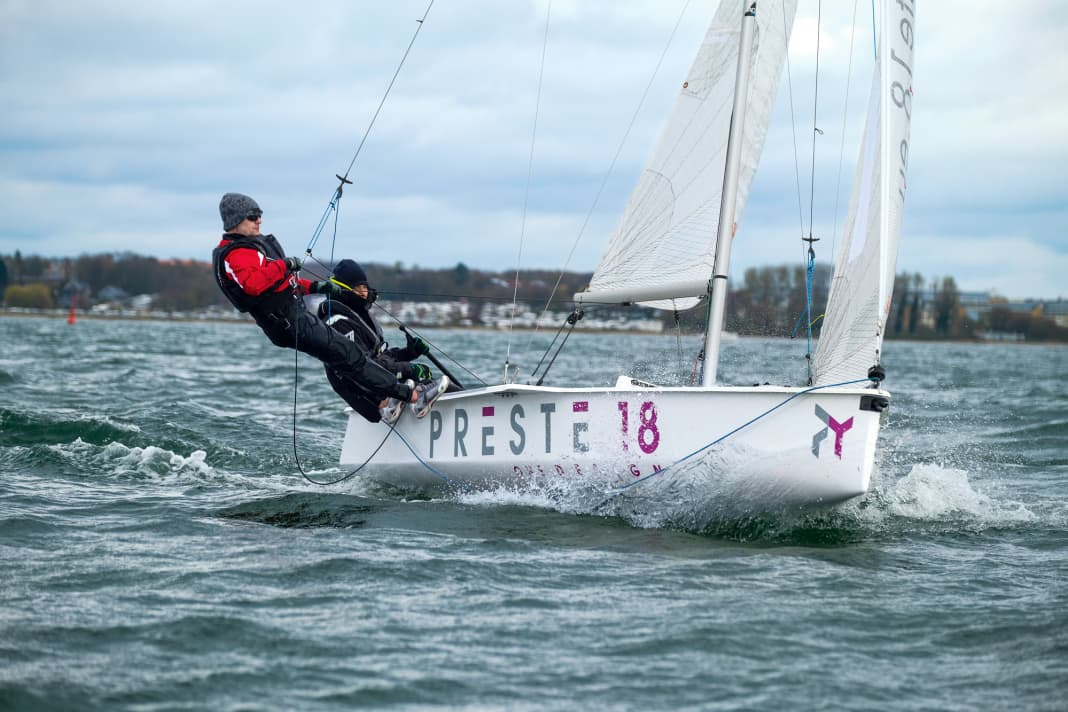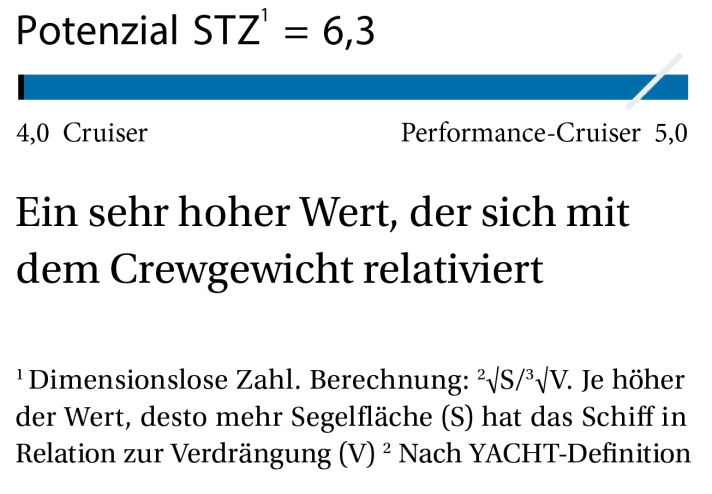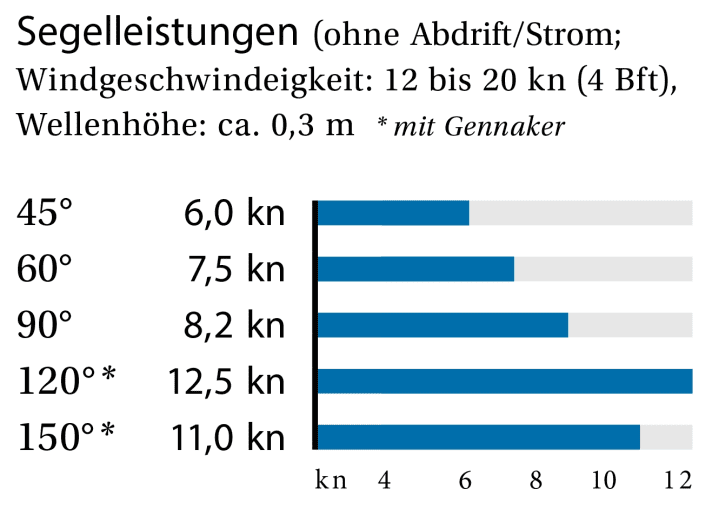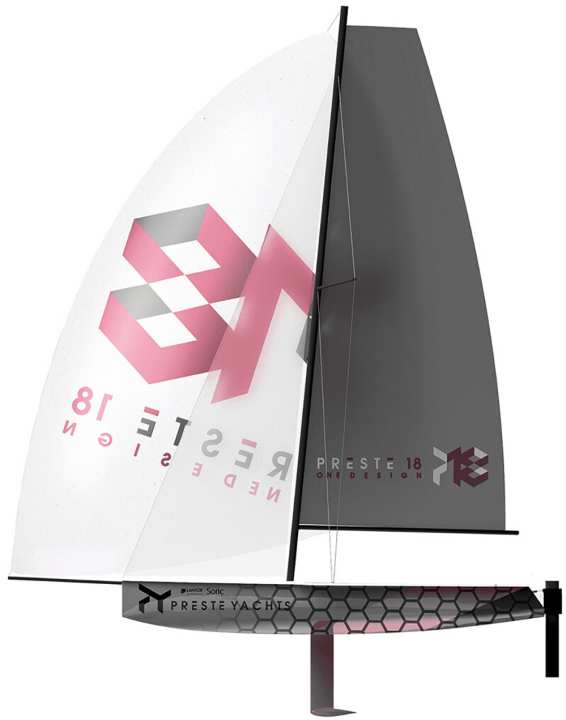Preste 18: A wild mix - half skiff, half keelboat. The keel dinghy in the test
Michael Rinck
· 31.05.2023






On the trailer at the slip ramp, the first thing you notice is the angular hull shape of the Preste 18. It is immediately reminiscent of skiffs such as the 49er. The deck even makes a striking leap outwards at the side so that the foresailor in the trapeze or on the edge can bring his body weight even better to windward. The outhaul straps extend from the mast to the stern, providing ample space for several co-sailors or, in the case of a two-person crew, room for longitudinal trim.
The Preste 18 is a keel dinghy
But one detail doesn't fit the picture: a tackle is attached to the mast, from which the supposed centreboard hangs. A look under the boat reveals that there is a lot of ballast on the fin. The attachment can quite rightly be called a keel. However, this means that the very light boat cannot be rolled into the water on a slip trolley; with a total weight of 360 kilograms (including the 80 kilos of ballast), a trailer with a towing vehicle is required.
In the water, the keel is lowered, secured with two screws and the tackle is removed. When you step on board, you immediately realise that this is a sports boat and not a tippy dinghy. Maciej Piasecki from Preste Yachts puts it in a nutshell: "The Preste 18 is a 49er for beginners." It is designed to offer a lot of sailing fun and high speed potential while also being very safe.
The keel dinghy is capsize-proof with ballast
The high stability provided by the ballast comes in handy on the test day. Off Neustadt, the average wind speed is twelve knots, which is ideal. But regular gusts of 18 to 20 knots of wind would be borderline on a dinghy without an experienced crew. Especially when the water temperature is six degrees. However, everything remains under control. The foresailor is upwind in the harness. The mainsheet is attached to the boom in such a way that it can be operated by the person on the tiller as well as in the harness. The boat leaves the harbour with the Schrick in the sheet at over seven knots.
Downwind, the speed over ground oscillates between 5.5 and 7.0 knots. The wake is clean behind the transom the whole time. However, the small waves, 30 centimetres high, are noticeable. If the crew slides further aft on the keel dinghy, the bow comes out of the water nicely. This shows that the Preste 18 reacts strongly to changes in fore-and-aft trim: if the crew sits too far forward on the wind, the rudder pressure increases. Otherwise it steers effortlessly, with little pressure and very small rudder angles, intuitively and agilely. No play or rattling in the rudder system. Very good.
However, you will oversteer in the first few turns as the rudder is initially set too high. The tiller jib is adjustable in length, which helps when riding out on the edge. However, it takes two to three tacks with the keel dinghy to find the right rudder angle and tiller arm under the low boom when you are sailing through. Then there's the timing with the foresailor in the trapeze.

The Preste 18 picks up speed quickly in strong gusts. Nevertheless, an active mainsheet trimmer is helpful here. The profile of the heavily flared mainsail then inverts in the upper third. Together with the ballast on the keel and the foresailor in the trapeze, the keel dinghy can be sailed very upright. This also makes the Preste 18 the fastest.
Super easy jib operation
The jib is furled on a furling system, which makes setting and retrieving very easy. There is also a self-tacking track: the sheet angle can be set using a trim line, and the sheet is held in a clamp on the mast. This makes it awkward for the helmsman to reach, but easier for the foresailor. However, there is hardly any need to change anything on the cross, even when tacking, the 7.5 square metre headsail goes through the wind independently.
If the sheets are furled a little for a half-wind course, the speed of the keel dinghy increases to 7.0 to 8.5 knots, sometimes even a little more.
Under gennaker the keel dinghy becomes a dinghy
Then up with the gennaker. The gennaker pole comes out of the bow by pulling on just one line and the space wind sail is set. The line is sheared endlessly, and the boom and sail can be hauled in again just as effortlessly in the other direction. As soon as the gennaker has wind, the log shows ten knots and more almost continuously. The Preste 18 slides effortlessly across the water. Now it's time for the crew to sit as far aft as possible. Because if the bow bites into one of the small waves, the pressure in the sails increases rapidly, and at one point the boat almost hits the sun.
But at such moments, the ballast comes to the rescue, the heel simply stops increasing from a certain point onwards, and so the flow around the rudder blade does not stop completely. After a brief moment of shock, the boat is back under control.
Pure sailing fun
The absolute top speed during the test run was 13.4 knots. The spray splashes around the bow, and the pressure in the sail can be precisely controlled with the smallest of course corrections. Nevertheless, Maciej Piasecki is not entirely satisfied; he had expected more speed in the gusts. But this is where the small, short wave sets a limit. Even with the crew weight shifted all the way aft, it slows the boat down slightly time and again.
But that doesn't detract from the sailing fun. The jibes also work straight away. Thanks to the large distance between the gennaker and forestay, the sheet goes to the other side without any problems. Only the sheet deflection at the height of the jib is set very far inboard, so you are constantly sitting on the windward sheet, which can interfere with manoeuvres. However, the shipyard has already thought about a change here to move the deflection further outwards. The mainsail should not be furled too far when there is a lot of pressure in the gennaker; boom jib over the aft edge of the hull is the maximum, Maciej points out. Otherwise the rig could become unstable without a backstay. But at high speeds, the apparent wind usually drops halfway, so you wouldn't furl the main any further even without the warning.

Everything that needs to be there
The trim equipment is straightforward: downhaul, cunningham and outhaul, that's it. The cockpit is very clean, only the outhaul straps lead from the mast to the aft. There is a cavity between the cockpit shell and the hull, which is accessible through several maintenance hatches. With a volume of 560 litres, it provides buoyancy should the Preste 18 capsize. A look inside reveals the honeycomb structure in the sandwich. Both parts are manufactured with polyester resin using vacuum infusion. The finish and the gelcoat surfaces look very good.
The prototype was completed in 2020, several boats are already in circulation in Poland and there are now also two dealers in Germany. Preste Yachts wants to further popularise the sporty one-design keel dinghy and conquer the German-speaking market. With the mix of racer and sports boat, the shipyard is trying to appeal to a broad target group.
Designed for regattas- or just like this
The Preste 18 is designed to win regattas as well as provide a relaxed and safe day of sailing with children or beginners. The all-rounder should also be ready to sail in under an hour - including setting the mast. With a complete weight of around 360 kilograms and thanks to the lifting keel, it can not only be craned, but also slipped. The 5.50 metre long one-design dinghy is therefore also suitable for an after-work trip for all those who do not have a mooring in the water.
Nevertheless, the Preste 18 is a compromise: too large and heavy for a pure sports boat, it also does not offer the necessary prerequisites for longer trips as a travelling dinghy. At 27,965 euros, it lies between the smaller Melges 15 (YACHT 3/2023) for 15,000 euros and the First 18 (YACHT 18/2022), which is roughly the same size but more suitable for cruising, for 40,000 euros. Here, the Preste 18 is positioned not only conceptually, but also in terms of price between the apparent opposites of sporty and fast and cosy and safe.
The Preste 18 in detail

Technical data
- CE design category C
- Hull length 5.54 m
- Total length 5.54 m
- Width 2.02 m
- Draught/recovered 1.35/0.35 m
- Rudder blade length 1.50 m
- Mast length 8.00 m
- Weight 360 kg
- Ballast/proportion 80 kg/22 %
- Mainsail 12.5 m²
- Self-tacking jib 7.5 m²
- Gennaker 29.0 m²
- Length of the seat cushions 2.20 m
- Width of the cockpit 1.53 m
- Crew 2 to 4 persons
Hull and deck construction
Vacuum infusion with polyester resin. The hull and deck are a sandwich with a honeycomb structure in the core
Equipment and prices
- Base price ex shipyard € 27,965
- Price with trailer € 30,265
- Warranty/against osmosis 5/10 years
Shipyard
Preste Yachts in Napachanie (Poland) www.preste18.eu
Distribution
Jörg Larisch: preste18@freenet.de
YACHT rating
With the One Design, Preste Yachts has created an interesting mix of racing and cruising elements
Design and concept
- + Sporty sailing
- + Lots of safety with keel
Sailing performance and trim
- + Simple rig
- + Strongly flared mainsail
- + Glides on quickly
- - Sheeting too far in
Equipment and technology
- + Furling and self-tacking jib
- + Retractable gennaker pole
- + single-line gennaker recovery system

